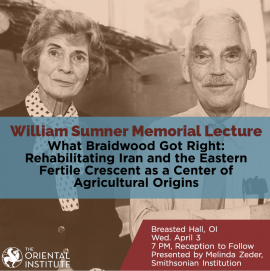William Sumner Memorial Lecture
"What Braidwood Got Right — Rehabilitating Iran and the Eastern Fertile Crescent as a Center of Agricultural Origins"
Melinda Zeder
National Museum of Natural History
Smithsonian Institution
Wednesday
April 3, 2019
7:00–9:00 pm
Breasted Hall
Oriental Institute
In the 1950s Oriental Institute archaeologists Robert and Linda Braidwood led the first systematic expeditions to Iran, Iraq, and Turkey focusing on one of the most significant transitions in human history - the origins of agriculture. The Braidwood expeditions were also the first to involve teams of scientists - botanists, zoologists, and geologists - to document the process and the context of the domestication of cornerstone crop and livestock species. Political events in the 60s and 70s caused a shift in the focus of archaeological studies of early agriculture to the Western Fertile Crescent region of modern day Israel and Jordan. Since then Iran and the rest of the Eastern Fertile Crescent has been portrayed as a backwater region lagging far behind the transformative innovations of the west. Recently, the application of new scientific methods to original collections from Braidwood and other early excavations in Iran and adjacent areas, as well as new excavations in the region, have overturned this notion. Not only has Iran and the rest of the Eastern Fertile Crescent been shown to be the heartland of domestication of a number of crop and livestock species, but Braidwood’s original explanation for these events has also turned out to be largely correct. This lecture reviews the history of research on agricultural origins in the Eastern Fertile Crescent and the landmark new studies that have rehabilitated it as a major center of domestication and agricultural emergence.


